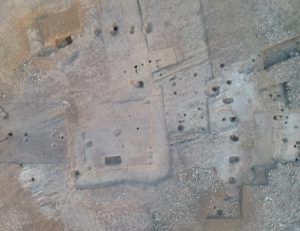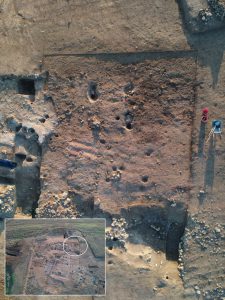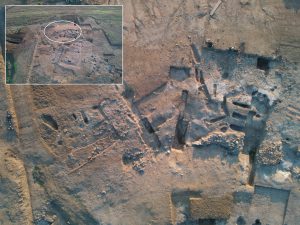The third archaeological excavation campaign on Vetricella site focused on the researches of a better understanding of the main historical dynamics of the site. In particular, with respect to an in-depth analysis of specific stratigraphic contexts, it dealt with the reconstruction of a stratigraphic sequence anchored, as much as possible, to accurate references of absolute chronology.
The research strategies pursued the chronological and functional definition of the first frequentation of the site, investigating on the II-III sectors in the areas close to the center of the settlement (Fig.1). This made it possible to identify the remains of a clear frequentation with structures made of perishable material, evidenced by alignments of pits concentrated in the central part of the site and connected to similar material proofs that emerged during the previous campaign.

The activities continued in the portions straddling the internal ditch (sectors III-IV), where the excavation activities had as their primary objective to reach the oldest stratigraphic levels (probably prior to the realization of the cutting of the ditch as for stratigraphic relationship), and the definition of the occupation methods developed out-side. The identified stratigraphies, revealed a repeated occupation of the area close to the internal ditch, probably connected to different productive activities. This information will help to define the character of possible activities related to metallurgical processing and grain storage (Fig.2).

The stratigraphic research was then concentrated in the area between sectors II and III, mainly characterized, by an extensive cemetery area which could be placed between the end of the X and the beginning of the XI century (Fig. 3). The area, partially investigated in the previous 2017 campaign, has been extended to the north to verify the real extension of the space intended to be the cemetery, and to identify any older burials, moving towards a phase of deepening in correspondence with the portions previously investigated. Finally, on the basis of the stratigraphic context sequence, we procedeed to the collection of 4 osteological samples to be submitted for a subsequent radiocarbon analysis.

Together with the stratigraphic excavation carried out on the site, exploratory trenches were opened to investigate the nature of the ditches (especially of the intermediate ditch). Phosphate analysis were peformed in the sector of the turriform building thanks to the collaboration with Prof. Jhoan Linderholm from the Department of Historical Studies, philosophical and religious studies of the University of Umeå as well as archaeobotanical and geochemical analysis of the soil nearby Vetricella site.


